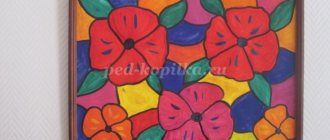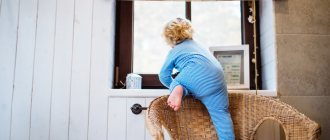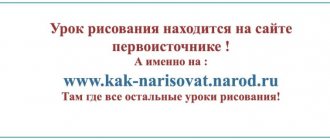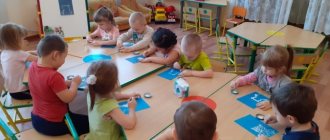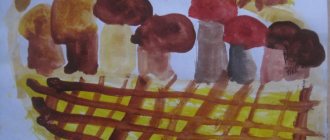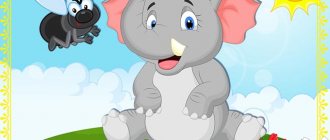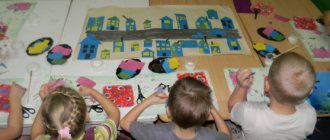November 29, 2016
Averyanova Sveta
A small child makes his first attempts to draw. He is interested in how to draw a squirrel with a pencil. You don't have to be an artist to help your child. There are special methods that allow you to quickly master the technique of depicting animals.
Using the step-by-step drawing method, you can easily depict any object on paper with a sufficient degree of similarity.
You can try to draw simple objects and animals (squirrel, fox, wolf, etc.) with a three-year-old child. Don't rush, don't criticize, and don't demand too much. If you criticize, your child may hate drawing.
Over time, if he is interested, the child himself will improve the technique of creating a drawing. With an older child, 5 or 6 years old, you can draw more complex drawings, for example, depict an animal on a tree. You can also start working with watercolors and gouache.
What do we need
For the lesson, prepare everything you need:
- sheets of white paper A 4;
- simple pencils;
- eraser;
- a set of colored pencils for coloring;
- templates of simple geometric shapes made of cardboard.
It is better to buy thick, slightly rough paper, since it will be difficult for a child to draw a squirrel on thin and smooth sheets. You can buy a soft pencil.
It’s also better to buy soft colored pencils; they color brighter, and you don’t need to press or wet them (some kids manage to put a pencil in their mouth before drawing so that it colors brighter).
Templates of geometric shapes (oval and others) are needed if the child does not yet know how to draw an oval, circle, square and triangle on his own.
The sizes of the figures must correspond to the details of the future squirrel drawing.
How to depict
To understand how to draw a squirrel step by step for children, you need to think about why they should be interested in this? Maybe you saw a squirrel in the park on a walk, or you recently went to the zoo and fed the squirrel nuts.
Or maybe my mother read Pushkin’s “The Tale of Tsar Saltan.” The depicted squirrel should resemble the one the baby saw and be as close as possible to the real appearance of the squirrel (not a photograph, of course).
To make the drawing more or less realistic, show your child step by step how to draw a squirrel with a pencil step by step. You can draw on a sheet without templates, and give your child the shape template that he must trace with a pencil.
If the child does not want to draw pictures with templates, let him learn to draw straight lines of figures himself. Everything will not be so fast and easy, and not so beautiful, but it will be interesting! First we draw an oval. You can accompany the lesson with poetry:
We drew an oval, we didn’t know what would happen.
1. At the top there is a smaller oval - the head of an animal, of course!
Let's draw legs for the animal so it can jump on the grass,
2. We draw the tail as fluffy, like that of a fast squirrel.
Ears, eyes, nose, mouth - a squirrel came out, not a cat!
The finished drawing of a squirrel can be finalized using a simple pencil or colored with colored pencils, erasing the extra contours of the geometric shapes (circles, etc.) with which the image was drawn.
Here is a step-by-step drawing of a squirrel you should get at the end of the lesson.
If the baby is tired, do not insist that the drawn masterpiece be completed; you can return to finishing drawing the squirrel later or the next day.
Young children find it difficult to focus on anything for longer than ten minutes. Never conduct drawing classes in a bad mood.
Your child may think that it is the drawing that makes you feel bad. It is better to postpone the lesson until the child and you have a desire to engage in fine arts. Then the baby will work with pleasure, and it will be easier for him to draw.
There are other, more complex ways to draw squirrel pictures for children, but it’s better to start with the simplest.
Abstract of the educational activity "Wild animals" Abstract of drawing "Squirrel"
Elena Timoshenko
Abstract of the educational activity "Wild animals" Abstract of drawing "Squirrel"
Senior group Theme " Wild Animals "
Abstract drawing " Squirrel "
consolidate and expand children's knowledge about protein (appearance, nutrition, behavioral characteristics to changes in the environment).
Learn to hold a pencil correctly;
a squirrel’s appearance .
Develop accuracy and neatness when working. The ability to bring something started to completion.
Foster a love of nature and respect for animals .
View the multimedia presentation “ Animals in Winter ”
, conversations about preparing
animals for winter .
Examination of illustrations and albums on the topic: “ Animals in winter ”
, compiling stories based on pictures.
Conducting didactic games “Who lives where?”
,
“Who eats what?”
,
Reading the works of V. Bianchi “Getting ready for winter”
and
"Teddy Bear
"
M. Prishvina “Squirrel Memory”
,
learning by heart the nursery rhyme “ A squirrel is sitting on a cart... ”
.
Handout. Sheets of paper with " Squirrel "
, colored pencils, wax crayons, photo illustrations or pictures of
a squirrel , poster “
Wild Animals of the Forest ” .
The simplest squirrel for children
If a novice artist wants to draw a squirrel, then he should use the simplest step-by-step technique. To do this you need to prepare:
- Simple pencil;
- Elastic band;
- Paper.
If everything is ready, then we proceed directly to drawing the animal:
- We start the drawing from the muzzle - draw a smooth line, add an ear in the form of a triangle and move on to the back.
- We draw the inside of the ear and nose, which is also depicted in the shape of a triangle. In the right place we place a slightly elongated eye with a pupil.
- We depict cheeks. To make the drawn line resemble fur, it must be drawn in a zigzag. Add a mouth between the top and bottom of the cheeks.
- Directly under the muzzle we draw the front legs, placing them one after the other.
We draw a zigzag line along the bottom of the paws. - We draw the squirrel’s hind legs, which should have a rounded shape at the top, and a flattened oval shape at the bottom. Create fur on the paws;
- We depict a fluffy tail using zigzags. It should start from the hind legs and go behind the back.
You can finish drawing the branch and move on to coloring. Younger children can only choose one color. And if a drawing lesson is held in an older group, then you can use several shades of orange.
MAGAZINE Preschooler.RF
Summary of an integrated lesson in the senior group “Visiting a squirrel” using an interactive whiteboardDEPARTMENT OF EDUCATION OF THE ADMINISTRATION OF THE CITY OF EKATERINBURG
Municipal budgetary preschool educational institution - general developmental kindergarten with priority implementation of activities on cognitive and speech development of pupils No. 121 MBDOU - kindergarten No. 121
Compiled by teacher of MBDOU No. 121 Romanova Natalya Aleksandrovna
Goal: to develop children’s ability to draw an animal according to a diagram, to consolidate their knowledge about the appearance and habits of squirrels in the forest (reserves).
Integration of educational areas: cognitive development, socio-communicative development, artistic and aesthetic development.
Software tasks:
Educational:
- Introduce children to the work of illustrator E. I. Charushin.
- To consolidate children's knowledge about the external structure of squirrels and their habitat.
- Teach children to draw first with a simple pencil according to a diagram, gradually conveying the shape of the animal.
Educational:
- Foster interest in understanding the natural world of the reserve.
- Enrich your vocabulary with possessive adjectives: squirrel.
- Foster a humane attitude towards animals.
Educational:
- Develop artistic taste, aesthetic feelings, imagination
- Develop the ability to convey the image of an animal according to a scheme.
- Unleash the creative potential of children.
Preliminary work
- View the multimedia presentation “Squirrels! What are they like ?
- Looking at illustrations on the topic: “Animals are preparing for winter”
- Conducting didactic games: “Whose house” , “Pick up a fur coat” , “Who sleeps in winter and who doesn’t” .
- Reading the works of M. Prishvin “Squirrel Memory” , learning by heart the nursery rhyme “A squirrel is sitting on a cart...” .
Planned results:
- The child knows about the squirrel’s habitat and its importance in the eco-system.
I Organizational part.
Motivation
Teacher: (makes a riddle)
The tail is a fluffy arch, do you know this animal? Sharp-toothed, dark-eyed, loves to climb trees.
(Squirrel)
Slide 2: (A squirrel appears on the screen)
Educator. - That's right guys! I would like to introduce you to the writer and artist Evgeny Ivanovich Charushin.
Slide 3: The teacher tells the children about the writer E.I. Charushin.
As a child, the little boy Zhenya and his mother treated animals, drew them, and observed them. Spent a lot of time outdoors with my dad. He especially liked animal children. The mysterious life of the animal world was inherent in the little boy Zhenya from childhood.
Slide 4: Guys, look at these are just a few stories that E.I. wrote. Charushin
Slide 5: Children, look at how Evgeniy Ivanovich painted a squirrel in his works. The teacher reads a poem by Vladimir Livshits about a squirrel.
The bunny is not used to working, the Badger is too lazy to work, only the housewife squirrel works all day long.
She scurries through the hazel trees, dexterous, agile, and collects nuts, large, selected ones.
He sits down, fluffs up his tail, and quickly peels off the bump. He jumps down, picks a fungus - Prepares for future use.
Collects soft moss - It's not bad for bedding. I've worked hard, I'm tired, I've finished my working day,
But there is a lot of goodness in the housewife's pantry. When the cold comes - There is a house and food.
The squirrel will jump into the hollow, It’s cozy and warm there, Softly, like in bed... Let the snowstorms blow!
Slide 6: Guys, let's look at the squirrel. What is she like? Describe it.
(children describe. Teacher summarizes and supplements):
— The squirrel is very small, about the size of a palm. She has ears with tassels, paws with claws, and is fluffy. The squirrel quickly jumps from branch to branch, and controls its tail like a rudder. When a squirrel sleeps, it curls up and covers itself with its tail like a blanket. The squirrel is a good housewife. A characteristic feature of many squirrels is their ability to store nuts for the winter, and they begin to do this in the summer. At the same time, some of them bury nuts in the ground, while others hide their reserves in tree hollows. But squirrels sometimes forget what and where they hid and the nuts sprout, thus, without meaning to, squirrels actively participate in the renewal of forests.
Slide 7: - Squirrels are preparing their homes for winter. Usually a squirrel has not one house, but several for sleeping, for wintering, and for breeding squirrels. A squirrel's house is called a “hollow”. But if there is no hollow, then the squirrel builds a nest for itself. The squirrel's winter coat is silvery, similar to snow. And in the summer - red.
Physical education moment
A squirrel is bored in a hollow, but it’s more fun on the ground. (I.p. - o.s. stretch, clap overhead.)
Jump-jump, jump-jump - she ran down the trunk in an instant. (Jumping around yourself with your hands in front (imitating the movements of a squirrel.)
I ran along the forest path into the dense forest. (Running in place)
And the fox is coming towards her, hide, little squirrel, quickly! (Sit down, covering your head with your hands.)
II. Main part.
Slide 8: Guys, let's see what shape the squirrel's head, body, and tail have? (children's answers)
Educator: - We will draw a squirrel with a simple pencil step by step: according to the diagram.
- We take a pencil and mark with ovals the places where the head, tail, paws and body will be.
- Draw the ears and tummy of the squirrel.
- Color the outlines of the squirrel.
Children draw a squirrel with a simple pencil, based on the diagram. Calm music sounds.
(Individual approach of the teacher to children).
Finger gymnastics:
A squirrel sits on a cart, (Claps palms and hits each other with fists alternately.)
She sells nuts.
To the fox - sister, (Bend one finger at a time, starting with the thumb.)
Sparrow, titmouse,
To the fat-fifted bear,
Bunny with a mustache.
To whom in a scarf, (Rhythmic clapping of palms and fist bumps).
Who cares,
Who cares?
Educator: - Now let’s dress our little squirrel in a beautiful red fur coat.
(Children color the squirrel with wax crayons, tracing the outline of a simple pencil with black wax crayon.)
Summarizing:
Educator: guys, let's remember what we know about the squirrel. Where she lives? What does it look like? What does it eat?
(Children's answers)
Educator: Children, why do you think a squirrel has such a fluffy tail?
(Children's answers.)
Educator: what benefits does a squirrel bring to nature?
(Children's answers).
Educator: guys, what writer-artist did we meet today?
Children: Zh.I. Charushin. He wrote about the animal world.
Slide 9: Educator: Well done! Let's see how wonderful the squirrels turned out. (Children look at each other’s drawings). I suggest collecting all the drawings in a beautiful box. I will send the squirrel these wonderful, beautiful friends you drew. Now the squirrel will not be lonely. (Children put the drawings in a box. A song about a squirrel sounds).
| Next > |
Draw a squirrel with a pencil
To draw a squirrel using only a simple pencil, you need:
- Prepare a base consisting of two equal circles, which should touch each other and resemble a tilted figure eight.
- From the point where the circles touch, draw a curved line (this will be the upper part of the thigh), and on the opposite side of the lower circle, draw a shorter line that will contact the tail.
- From the upper circle create a squirrel's muzzle and front legs with claws, add ears on top.
- Using a wavy line, form the curve of the back.
- Draw an eye, a nose and a slightly noticeable outline of the mouth on the head.
- Add a tail and remove unnecessary lines with an eraser.
All that remains is to “dress” the animal in fur, which is created using thick strokes. You can “give” a nut or other treat to the paws.
